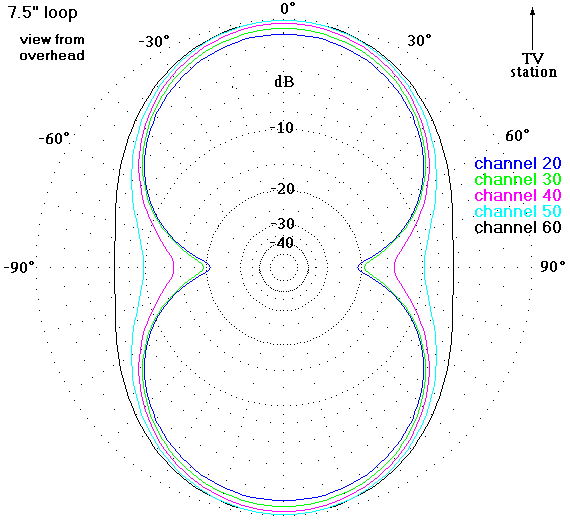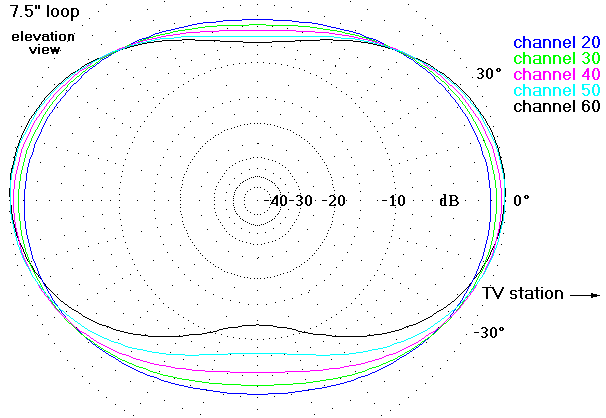6/9/15


The 7.5” loop
is representative of a large class of indoor antennas built around a loop or
something similar. These may include
units with amplifiers or switched “tuning circuits”, and frequently VHF rabbit
ears are included.
Simple loops
If this is
all you need, great! Some simple
improvements are possible :
- You can add three feet of
twin-lead (300 ohm ribbon cable) to it.
This will get it away from the body of the TV set and allow you to
rotate it. But twin-lead must
always be kept one inch from anything metal and must not touch any
substantial thing that is plastic.
- You can rescale the loop for your
weakest channel. Use this formula :
dia=4537/(6*N+389) where N is the channel number
(14-69). (Plugging 36 into this
formula will give you 7.5. Multiply
that by 3.141 to get the total wire length.) 12 or 14 gauge copper wire is fine. Remove any thick insulation.
- Higher gain is possible with a
double-loop (A2 on the gain graphs).
However it has a narrower bandwidth. This “figure-8” antenna should look like
two tangent circles, one above the other, fed at the bottom. Keep the wires a quarter inch apart at
the crossover point. This formula
gives the diameter of each circle :
dia=4244/(6*N+389) Multiply this by 6.283 to get the total
wire length.
Units with
amplifiers
In most cases
all the amplifier does is allow the maker to claim a high gain number. As was explained in the section “Antenna
Basics”, the amplifier will compensate for loss in the cable but will not
improve the antenna. The loss in the
four feet of cable that comes with the antenna is probably not
significant. The true gain for a loop
antenna is what is shown in the net gain graph, not what the maker claims.
Most
receivers have a UHF noise figure somewhere in the range 3-10 dB, with 5 dB
being typical. If the antenna amplifier
has a noise figure below 3 dB then you can assume it is probably quieter than
the receiver. In this case, the
difference between these two numbers represents an improvement provided by the
amplifier, and the amplifier is a good idea.
But few indoor amplifiers are that good.
If the noise figure is not listed on the packaging then you can assume
the amplifier is not quiet enough to be an
improvement over the receiver.
It may be
reasonable to buy an amplified indoor antenna if :
- the amplifier has a noise figure
below 3 dB.
- you need a longer cable to reach
a good reception spot.
- you want to feed two sets using a
splitter.
- you want to recover the 1 dB loss
in the 300W-to-75W balun
and the coaxial cable.
- your TV has 300W UHF terminals. The amplifier can overcome high ribbon
cable loss where the rules can’t be followed.
Units with tuners
Many indoor
antennas have a rotary switch on them that you must set each time you change
channels. This switch improves the match
between the antenna and the feedline. When effective, it makes the net gain as good
as the raw gain. But in some cases it is
mainly for the VHF channels and does a poor job on UHF. (There is no way to tell before you buy.) A UHF-only antenna with a tuner is a good
buy. You may find you can tune it to
your weakest station and forget about it.
This page is part of “An HDTV Primer”, which
starts at www.hdtvprimer.com